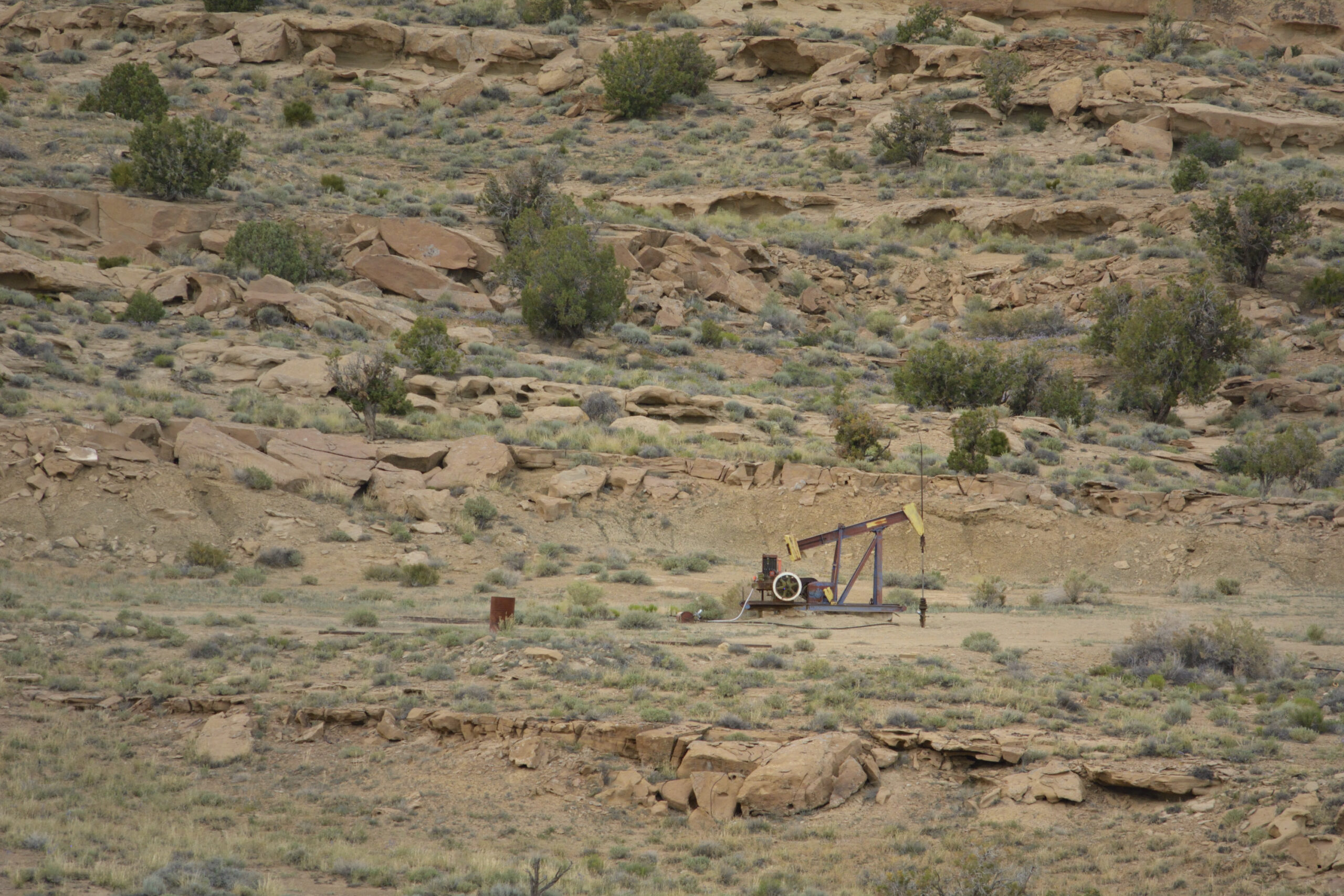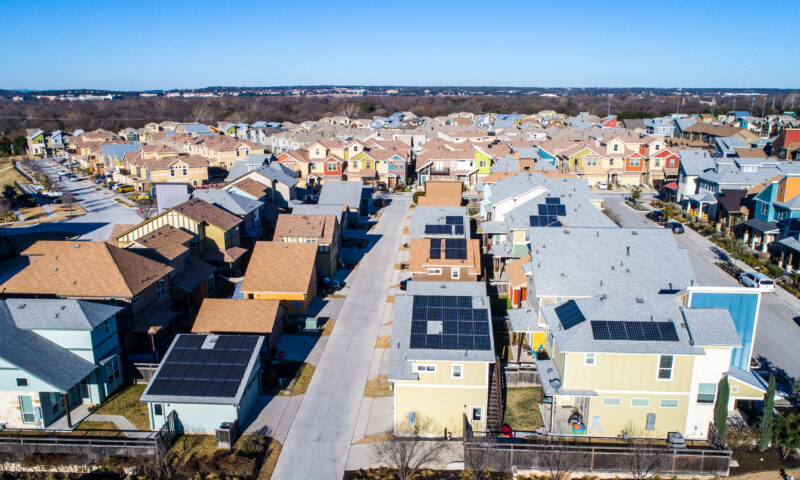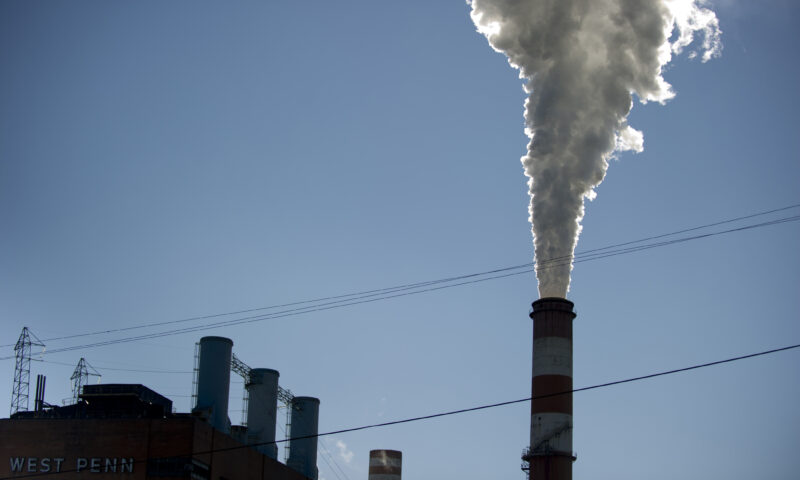The company at the center of a controversial green energy project connecting New Mexico and Arizona has changed plans for a key component: A much-debated pipeline that would have carried climate-friendly hydrogen will instead carry natural gas, and possibly a natural gas-hydrogen blend at a future date. Unlike hydrogen, natural gas, blended or not, contributes to climate warming both in its production and when it is burned for energy.
The pipeline is part of a much larger project by Tallgrass Energy Partners LP that would create a hydrogen economy centered in Farmington in the northwest corner of New Mexico. Plans include hydrogen production, a massive hub to inject carbon deep underground, repurposing a mothballed coal-fired power plant as a hydrogen-fired power plant, and pipelines connecting the various parts. The plans also included one pipeline to carry hydrogen across the Navajo Nation to markets in Arizona and farther afield.
Tallgrass decided to change what would be delivered in the pipeline earlier this year, and the news surprised many. Starting in 2021, the company, working through its subsidiary GreenView, carried out a public relations campaign along the proposed pipeline route through the Navajo Nation, hyping the green benefits of hydrogen. Switching to natural gas or a gas-hydrogen blend would dramatically reduce or eliminate those benefits.
Tallgrass and GreenView also negotiated directly with the top level of the Navajo government about the project, most recently Navajo Nation President Buu Nygren. But when asked about the change to natural gas, Bidtah Becker, chief legal counsel for the president’s office, said, “It clearly was a decision that had been made long before we were informed.”
Common methods of producing hydrogen use natural gas as a feedstock, creating large quantities of climate-warming carbon dioxide.
Many embraced the project in a region that has seen declining oil and gas production and associated revenues from the surrounding San Juan Basin, as well as the closure of a large coal-fired power plant and its mine. The project also drew sharp skepticism on and off the Navajo Nation, where more than a century of industrial mineral extraction and production has failed to produce widespread economic benefits to residents.
Unlike fossil fuels, many see hydrogen as a miracle fuel. It produces only water vapor as a byproduct when run through an electrolyzer to make electricity and it produces no climate-warming carbon dioxide when burned, though it does emit other noxious air pollutants.
However, common methods of producing hydrogen use natural gas as a feedstock, creating large quantities of climate-warming carbon dioxide that need to be permanently buried underground — which is difficult, expensive and often unsuccessful — if the fuel is to be considered climate friendly.
Steven Davidson, vice president of government and public affairs at Tallgrass, said the change “does not indicate a departure from our commitment to clean hydrogen production and [carbon dioxide] sequestration. Instead, we are strategically positioning the project to meet both current and future energy demands.”
The change would make a pipeline capable of carrying natural gas and a blend of natural gas and hydrogen in the future, Davidson said: “In short, definitely no deviation from our focus on clean hydrogen as a decarbonization solution.”
That solution includes working with the Navajo Nation, he added. “We have invested four years of our time and resources in true partnerships to invest with the Navajo people,” he said. “We are a group of one in that respect.”
Joe Romm, a senior research fellow at the University of Pennsylvania’s Penn Center for Science, Sustainability and the Media and a former acting assistant secretary for energy efficiency and renewable energy at the U.S. Department of Energy, is doubtful about the project’s overall prospects.
“In the real world, you don’t see [projects] like this happen a lot, something so complicated,” he said. So big hydrogen projects are the result of “powerful backers. And the most powerful is the oil and gas industry.”
The complication starts with transporting blended gas.
“Blending doesn’t make a lot of sense. You can’t blend a lot” because the chemical nature of hydrogen “will basically tunnel through and destroy normal steel and a lot of other things,” Romm said.
By comparison, long-distance natural gas pipelines have been around for decades (though they aren’t risk-free).
“You can’t find a successful major carbon capture and storage [project].”
~ Joe Romm, Penn Center for Science, Sustainability and the Media
Then there is the basic math of the most common method of making hydrogen from natural gas: steam methane reformation. According to researchers at Texas A&M University, it requires 3.16 kilograms of natural gas and another 9.74 kilograms of water to make a single kilogram of hydrogen. That process also creates 8.47 kilograms of climate-warming carbon dioxide. The formula doesn’t include the fuel needed to power the process or the energy needed to sequester the carbon dioxide to keep the hydrogen’s green credentials.
That carbon sequestration hub would be another sticking point because carbon capture projects are hard. “You can’t find a successful major carbon capture and storage [project],” Romm said.
Furthermore, natural gas production itself is an inherently leaky process, and the methane in the gas is 80 times more effective at trapping heat in the atmosphere than carbon dioxide.
With all of these complications inherent in hydrogen production and transport, Romm said, “Just pipe the natural gas.”
The pipeline change came at roughly the same time that a member of the Arizona Corporation Commission asked the commission to study building more natural gas pipelines and storage facilities for the state. Among other duties, the commission oversees pipeline safety and power utilities.
Nick Myers, the Arizona commission vice chair, said he hadn’t heard of the GreenView pipeline project when he asked the commission to study such projects. “To the extent I may have been informed, but don’t remember, it was only in passing,” he said. “I would love to talk to someone just to be in the loop.”
Tallgrass’ Davidson said, “We were not involved in the [commission’s] decision.” But, he added, “It’s not surprising,” considering that AI data centers alone are projected to consume up to 16.5% of the state’s power grid by 2030.
“None of the [other] pipelines that are proposed to be built into Arizona, to the best of our knowledge, provide any value to the Navajo Nation,” Davidson added.
So far, Myers’ February memo to the commission has prompted 17 letters on possible new natural gas infrastructure in Arizona. All but two were in favor, and six specifically mentioned the GreenView natural gas pipeline.
One of those letters was co-authored by New Mexico state Rep. Meredith Dixon (D-Albuquerque), who promoted and regularly voted in favor of fossil-fuel-friendly legislation during the state’s two-month legislative session earlier this year. She also cosponsored legislation that set up a framework for the state to manage carbon sequestration projects such as the planned CarbonSAFE hub in northwest New Mexico that’s part of Tallgrass’ overarching hydrogen project. (Gov. Michelle Lujan Grisham signed the bill into law on April 7.)
For the past few years, grid-scale solar and wind energy have been cheaper to install than any fossil fuel.
Dixon’s co-author of both the letter and the legislation was state Sen. William Sharer (R-Farmington), the Senate minority floor leader and a longtime champion of oil and natural gas production. His district covers a large portion of the San Juan Basin in northwest New Mexico. Among the perceived benefits, the legislators championed the natural gas pipeline as “a unique opportunity to uplift the Navajo Nation,” despite the fact that oil and gas have been produced for more than 100 years on the economically challenged reservation. The letter doesn’t note them talking with anyone from the Nation, either.
In an email, Dixon said, “Even as [Sharer] and I disagree on some principles, we agree on the important role of carbon storage.”
Dixon didn’t say how she heard about the GreenView pipeline change, apparently before many on the Navajo Nation did. But she did offer reasons for supporting it: the argument of natural gas as a so-called “bridge fuel” (which is often–debunked); national and international security risks in light of the Russian invasion of Ukraine (which are debatable); and the real lack of other readily available power sources for energy-intensive manufacturing processes and transport.
Groups ranging from the United Nations’ Intergovernmental Panel on Climate Change to the Rocky Mountain Institute support using hydrogen in energy-intensive industrial processes and heavy transport — but not elsewhere. That’s because for the past few years, grid-scale solar and wind energy have been cheaper to install than any fossil fuel. In fact, solar projects are growing across the Navajo Nation as part of a federal program to electrify Native lands. And the Environment America Research & Policy Center ranked New Mexico fourth in its top 10 list of states for renewable energy.
“My letter is intended to highlight potential opportunities created by this project,” Dixon said. “I fully expect Tallgrass to engage with all affected tribal and non-tribal communities.”
Three more letters that share similar structure and language and came from businesses on or near the Mexican border may be the work of LS2group, which calls itself “a bipartisan public relations, government affairs, public affairs, and marketing firm.”
Josh Rubin, the vice president of a cross-border manufacturing facilitator in Nogales, Arizona, 300 miles from the pipeline, told Capital & Main that a friend at LS2group asked him to send the letter, though he wasn’t overly familiar with the project.
A second letter, signed by a Holly Jensen claiming to own a Groovy Hues painting franchise in Tucson, couldn’t be verified. Neither name is affiliated with a registered business in Tucson, though there is a Groovy Hues 113 miles away in Phoenix, registered to a different person. And a call center operator for Groovy Hues said the company doesn’t do business in Tucson.
A third letter writer, Michael Sene, who runs a truck repair shop on the border, didn’t respond to a call and message from Capital & Main.
LS2group also did not return calls from Capital & Main.
Jessica Keetso (Diné) is deeply familiar with the GreenView project. For three years as an outreach coordinator for the Native group Tó Nizhóní Ání, or Sacred Water Speaks, she led an educational campaign opposing the hydrogen pipeline. (She recently left the group to attend law school.)
Even so, she first heard about the change from hydrogen to natural gas from Capital & Main, though she suspected something was in the works. “We knew something was happening because of how little presence Tallgrass had in the community” in recent months, she said.
“I think the Nation was always uncertain about the market for hydrogen,” she added. As for the pipeline change, “I think it’s really going to push the Navajo Nation for more benefits.”
Keetso said tribal agencies had already devoted a lot of time and energy working on the initial GreenView proposal, and changing the fuel could restart the whole process. She said that when she asked regulatory agencies on the Navajo Nation what would be required for changing the long-debated hydrogen pipeline to natural gas, they hadn’t heard of it.
“People freaked out,” she said.
Copyright 2025 Capital & Main


 The SlickNovember 14, 2025
The SlickNovember 14, 2025
 Latest NewsNovember 11, 2025
Latest NewsNovember 11, 2025
 The SlickNovember 12, 2025
The SlickNovember 12, 2025
 Column - State of InequalityNovember 13, 2025
Column - State of InequalityNovember 13, 2025
 Latest NewsNovember 19, 2025
Latest NewsNovember 19, 2025
 Latest NewsNovember 18, 2025
Latest NewsNovember 18, 2025
 Latest NewsNovember 17, 2025
Latest NewsNovember 17, 2025
 The SlickNovember 18, 2025
The SlickNovember 18, 2025

